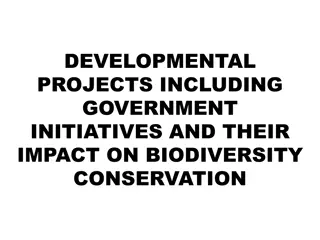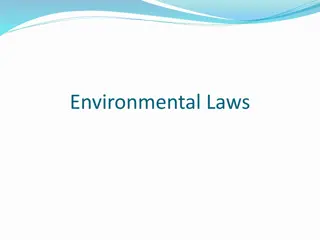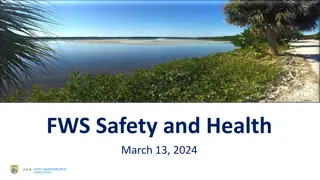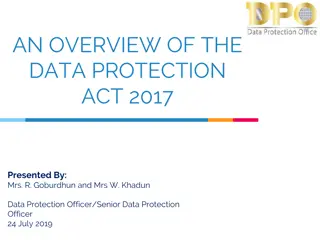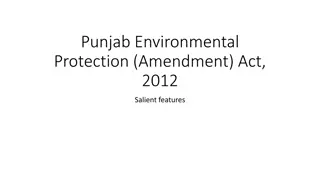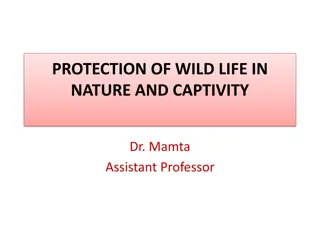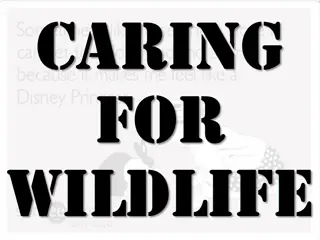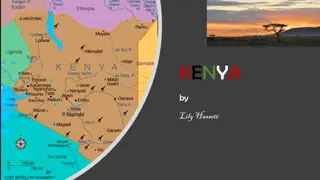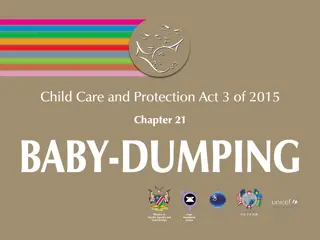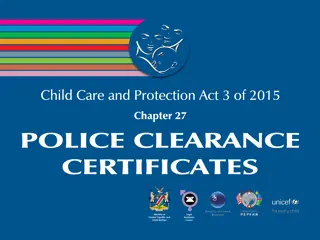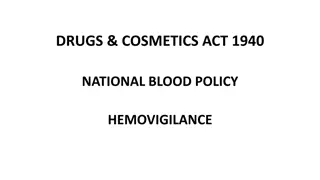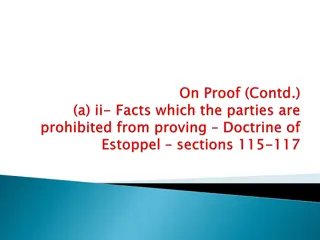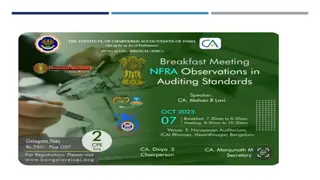Wildlife Protection Act, 1972 - Important Sections and Rules
The Wildlife Protection Act of 1972, along with its amendments, defines and protects wildlife and their habitats. Key sections include the declaration of sanctuaries, restrictions on entry, permits for entry and study, and immunization of livestock near sanctuaries.
- Wildlife Protection Act
- Sanctuary Declaration
- Entry Restrictions
- Livestock Immunization
- Wildlife Conservation
Download Presentation

Please find below an Image/Link to download the presentation.
The content on the website is provided AS IS for your information and personal use only. It may not be sold, licensed, or shared on other websites without obtaining consent from the author. Download presentation by click this link. If you encounter any issues during the download, it is possible that the publisher has removed the file from their server.
E N D
Presentation Transcript
ACTS AND RULES RELATED TO ZOO AND WILD ANIMALS Dr. Pallav shekhar (Assistant Professor)
Wildlife Protection Act, 1972 This was amended in the year 1991. According to this act, Wildlife is defined as any animal, bee, butterflies, crustaceae, fish and moths and aquatic or land vegetation . Thus it is to be understood that Wildlife is the term that embraces all life forms that are wild or care themselves. There are many important sections of this act which are to be understood
SECTION-18 Declaration of Sanctuary The State Government may by notification declare its intention to constitute any area or area comprised with any reserve forest or territorial waters as Sanctuary if it considers that such area is of adequate ecological faunal, floral, geomorphological, natural or zoological significance for the purpose of protecting, propagating or developing wildlife or its environment
SECTION 27 Restriction of entry in Sanctuary No person other than a public servant on duty a person who has been permitted by the Chief Warden or the authorized officer to reside within limits of the sanctuary. a person who has any right over immovable property within limits of the sanctuary. a person passing through the sanctuary along a public highway and the dependents of the person classified in class (1), (2), (3) shall enter and reside in the sanctuary, except under and in accordance with the conditions of a permit granted under section 28
SECTION 28 Grant of permit The Chief Wildlife Warden may on application grant to any person a permit to enter or reside in a sanctuary for all (or) any of the following purpose: Investigation or study of Wildlife and purposes of ancillary or incidental threats. Photography Scientific research Tourism Transaction of any lawful business with any person residing in the sanctuary. A permit to enter or reside in a sanctuary shall be issued subject to such conditions and on payment of such fee as may be prescribed.
SECTION 33 A Immunization of Livestock The Chief Wildlife Warden shall take such measures in such manner as may be prescribed, for immunization against communicable diseases of livestock kept in or within 5 kms of the sanctuary. No person shall take or cause to be taken or grazed any livestock in a sanctuary without getting it immunized.
SCHEDULES Schedule I to VI are dealt by Wildlife Protection Act 1972 with amendments during 1986 and 1991. Important animals in each schedule are given below: Schedule I Part I Mammals oIndian chinkara, Indian lion, Indian wild ass, Indian wolf, leopard, leopard cat, Lion-tailed macaque, Loris, Gaur or Indian Bison, Cheetah, Indian gazelle, Dugong, Nilgiri Tahr, Niligiri langur, Musk deer, Sloth bear, Tiger, Wild Buffalo, Mouse deer, Hog badger, Hispid Hare, Chinese pangoling, Crab-eating macaque, Desert fox, Fishing cat, Four-horned antelope, Indian one-horned Rhinoceros, Rusty spotted cat, Serow, Swamp deer etc. Part II Amphibians and Reptiles oPythons, Water lizard, Gharial, Estuarine (or) Salt water crocodile, Golden Gecko, Green sea turtle, Leathery turtle, Logger head turtle, Hawksbill turtle, Indian egg-eating snake. Part II A Fishes oWhale shark, Shark, Ray, Sea horse, Giant grouper. Part III Birds oHornbills, Mountain quail, Peafowl, Andaman teal, Nicobar megapods, Nicobar pigeon, Bengal florican, Black-necked crane etc. Part IV Insects oButterflies and Moths. Part IV A Coelentrates oFire coral, Sea fan, Roof building coral. Part IV B Mollusca Part IV C Echinodermata
Schedule II Part I Bonnet macaque, Common langur, Wild dog, Chameleon, Spiny tailed lizard or Sanda. Part II Beetles. Schedule III Chital, Barking deer or Muntjac, Gorals, Hog deer, Wild pig, Nilgai, Sponges. Schedule IV Indian Hedgehogs, Indian porcupine, Mongooses, Polecats. Schedule V Common crow, Fruit bats, Mice, Rats, Five striped palm squirrel, Black napped hare, Common Indian hare, Desert hare, Himalayan mouse hare. Schedule VI Birds like Coots, Cranes, Cormorants, Flamingos, Ibises. Ladies slipper orchids, Red Vanda, Blue Vanda.
Following are the important definitions in this: Chairperson means the chairperson of the National Biodiversity Authority (NBA) or as to case may be of the State Biodiversity Board. Member means a member of the National Biodiversity Authority (NBA) or a State Biodiversity Board and includes the Chairperson. Bio-survey and Bio-utilization means survey or collection of species, sub species, genus, components and extracts of biological resource for any purpose and includes characterization, inventorisation and bioassay. Value added products means products containing potions or extracts of animals as well as the plants in unrecognizable and physically inseparable form
Other acts The Forest (conservation) Act, 1982. The Indian Forest Act, 1927. The Indian Fisheries Act, 1897. Elephant preservation Act, 1879. Bengal Rhinoceros Act, 1932. Bombay Wild animal and wild birds Protection Act, 1951. The Cruelty against animals Act, 1960.


